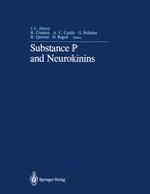1987 | OriginalPaper | Buchkapitel
Evidence for the Zipper Model in Tachykinin Receptor Binding
verfasst von : G. C. Landis, B. S. Wire, T. F. Burks, D. L. Kreulen, V. J. Hruby
Erschienen in: Substance P and Neurokinins
Verlag: Springer New York
Enthalten in: Professional Book Archive
Aktivieren Sie unsere intelligente Suche, um passende Fachinhalte oder Patente zu finden.
Wählen Sie Textabschnitte aus um mit Künstlicher Intelligenz passenden Patente zu finden. powered by
Markieren Sie Textabschnitte, um KI-gestützt weitere passende Inhalte zu finden. powered by
The kinetic effects of conformational selection will depend on the mechanism by which substance P (SP) binds to its receptor. There are two contrasting models which have been proposed for SP: (1) the ‘zipper’ model1; and (2) the ‘lock-and-key’ model2. To understand the binding mechanism in more detail, conformationally constrained analoqs involving the 5–11, 6–11, 5–9, and 5–10 segments were previously designed1,3,4,5 to duplicate the proposed conformation necessary for binding and signal transduction6,7,8,9. We now have prepared several restricted analogs to allow the 5–8 segment of SP free rotation while restricting the 9–11 C-terminal segment. These analogs demonstrate increased activity in the guinea pig ileum when compared to a previous series of analogs which were restricted from the Gln5 (or Gln6) position to the Met11 position1. Also, these analogs did not demonstrate any antagonist activity on the guinea pig ileum against SP or SK at 10 μM.
